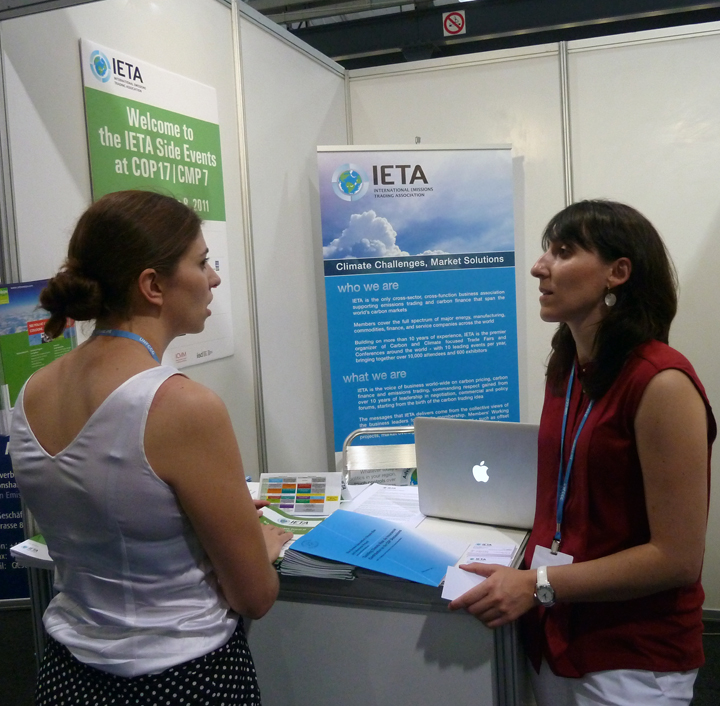Note: Anne Petermann and I went to our first UNFCCC COP (Conference of the Polluters) in 2004 in Buenos Aires, Argentina. One of my first observations was that this was a bizarre trade show–from ‘clean coal’ to ‘clean nuclear’ to a clean way to get fucked. Smile. I was not impressed. Well, going into the exhibition center was more exciting than the plenaries packed with, for the most part, suited charlatans. Fast forward to Montreal, Nairobi, Bali, Poznan, Copenhagen, Cancún and now all the way to Durban, South Africa; and guess what?–the 1% have been and still are in control (for now). But one of the good things that has happened over these years is that the resistance has risen from a couple of handfuls of us to thousands. It is evident to GJEP that the COP process is nothing more than the rich figuring out how to make more money off Mother Earth and her inhabitants under the guise of addressing climate change. So this photo essay, with text by Anne Petermann, is my parting shot to this entire unjust, racist, classist, land-grabbing COP crap. No to the next meeting in Dubai and yes to mobilization for the Peoples Summit during Rio +20. GJEP will continue to support the social movements, Indigenous Peoples and those who struggle for justice. Please enjoy the trade show photos and note that the last two photos in this series show the discrepancy between the 1% and the 99%. Orin Langelle for the GJEP Team.
All photos: Langelle/GJEP Captions: Anne Petermann

The Road to Rio. “Wait, I think we spelled that wrong–isn’t it supposed to be “Greed Economy”?
“Ohm…no Fukushimi…Ohm…no Fukushima…”
” Look into the blank screen… You are feeling sleepy…Join us…join us…join us…repeat after me…I believe in the green economy…Robert Zoellick is a nice guy…REDD will save the forests…The World Bank’s mission is poverty alleviation…”
What the World Bank said…
“Carbon bubble, what carbon bubble? A ton of carbon is supposed to be cheaper than a pizza. Isn’t a pizza made of carbon? It all makes sense to me!”
“With the Green Economy we can even make fabrics out of tree pulp! Fabulous Fashions From Foliage! Yummy Eucalyptus unitards! Perky Plantation Pant Suits! Thank God for the Green Economy!”
“We help cool down climate change by logging tropical forests…What, you gotta problem with that?”
“We magically transform ancient tropical forests into biodiesel plantations!. Birds love ’em! (F*#k the orangutans).”
” Oooo…that panda makes me so hot…”
People need nature to thrive–which is why we have to protect nature from them!
“These charts clearly show that it’s the NGOs that are responsible for carbon emissions. That’s why we have to ban NGOs from the climate talks; if there were no NGOs there would be no climate change. Listen to me. I’m a white guy and I know.”
“Screw you anti-capitalist NGO bastards. Market-based schemes like the CDM are the best solution to climate change! So what if they don’t reduce carbon emissions. Piss off.”
How the 1% live. The pretentious Southern Sun Elangeni Hotel in Durban was host to the World Climate Summit, 3-4 December, which was a high-level and high-security event where business, finance and government leaders met to celebrate the glory of their green-ness with events like “The Gigatonne Award” for whatever company’s PR campaign was the biggest pile of “green” manure.
The following week the corporate conference sponsors offered side events for UN government delegates on the theme of “Advancing Public-Private Partnerships for REDD+ and Green Growth” i.e. how to ensure profit-making as usual in the face of ecological collapse and rising public outrage.

How the 99% live. This tent was where the delegation met that came to Durban with La Via Campesina, the world’s largest peasant organization. Their slogan, Small Farmers Cool the Planet, confronts the myth that governments and the UN will take care of climate change for us and promotes the idea that bottom up, small scale, community-controlled and bioregionally appropriate solutions are what is needed. The building behind the tent was where La Via slept and ate meals–not as pretentious as the Southern Sun Elangeni Hotel, but the people were real.
 Global Justice Ecology Project teams up with KPFK Sojourner Truth Radio each week to produce the Earth Minute and Earth Watch segments. Listen this week for updates on the WTO ministerial in Bali, Indonesia, where water privatization is on the table and peasant movements are rising up against the continued commodification of life and land.
Global Justice Ecology Project teams up with KPFK Sojourner Truth Radio each week to produce the Earth Minute and Earth Watch segments. Listen this week for updates on the WTO ministerial in Bali, Indonesia, where water privatization is on the table and peasant movements are rising up against the continued commodification of life and land.















